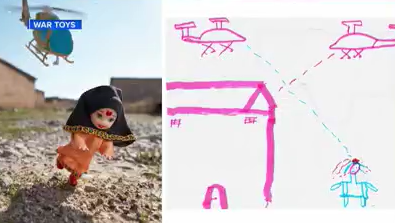Group uses art therapy to help children of war
Testing on staging11
(NewsNation) — Cheerful colors, stick figures and imagination. At first glance, these photos appear to be simply illustrations by children. But the drawings carry a deeper meaning, an expression of the devastation and destruction witnessed by the young artists along with a hope they will heal.
The drawings represent children caught in the middle of war. With each stroke of the pen, war’s youngest victims recreate firsthand accounts of both loss and survival. It’s what Brian McCarty describes as “war from the perspective of innocence.”
McCarty serves as the executive director of “War Toys.” The California organization uses art therapy to help children impacted by war.
“They are the youngest victims. As you said, they’re the most innocent,” McCarty said Sunday on “NewsNation Prime.” “And by looking at their accounts, which is kind of undervalued up until now, we get to see war from the perspective of innocence.”
The organization connects with the children through established non-governmental organizations or United Nations agencies to conduct what they call art-based interviews. Over the course of several sessions, the children will become familiar with an art therapist and share their stories.
“They’ll share experiences that they want the rest of the world to know about. And then she amazingly can take them into this mindset and then bring them back out. So even though they’re sharing the worst things that have happened to them, they still leave with waves and smiles,” McCarty said.
War Toys was founded in 2019, but its efforts trace back to 1996. The group is specifically known for a photo series McCarty has been working on since 2011, where he returns to war-torn places to produce pictures based on the drawings from children in art therapy.
“Once we have the drawings, then it’s creating the photographs, we don’t take the children with us because it would be unsafe, physically, mentally, and just ethically wrong, to immerse a child into these scenes. And so we find local toys; we go the actual places and we recreate the events as best we can,” McCarty continued.
The product of these art therapy sessions and photographs? Hauntingly beautiful pieces that in their conception may have helped a child process what happened during war and allowed them to heal from the trauma.

“Art therapy in general, it is the best tool for working with traumatized children, especially in war zones, children at the ages that they are, they have the cognitive ability, they’ve experienced all these things just the same as an adult would, but they don’t have the language skills. So they can’t sit there and tell you about their experiences,” McCarty said. “So it takes these … more subjective approaches and someone who’s really trained to be able to work effectively with that, but it makes such a difference. Just having someone listen and validate the experiences and help them process them is so incredibly important.”
In the weeks following Russia’s initial invasion of Ukraine, millions of people have been forced to abandon their battle-scarred homeland. Through the art therapy program, McCarty now hopes to amplify the voices of Ukraine’s youngest refugees.
“The biggest takeaway is that children’s experiences are the same no matter where you go. Despite cultural differences, geography, all those types of things, it’s exactly the same. What a child experiences in Ukraine really is no different than a child in Syria or Iraq or anywhere else. And that really is the bottom line. These children all, everywhere, deserve safety and security.”
Learn more about War Toys here.



